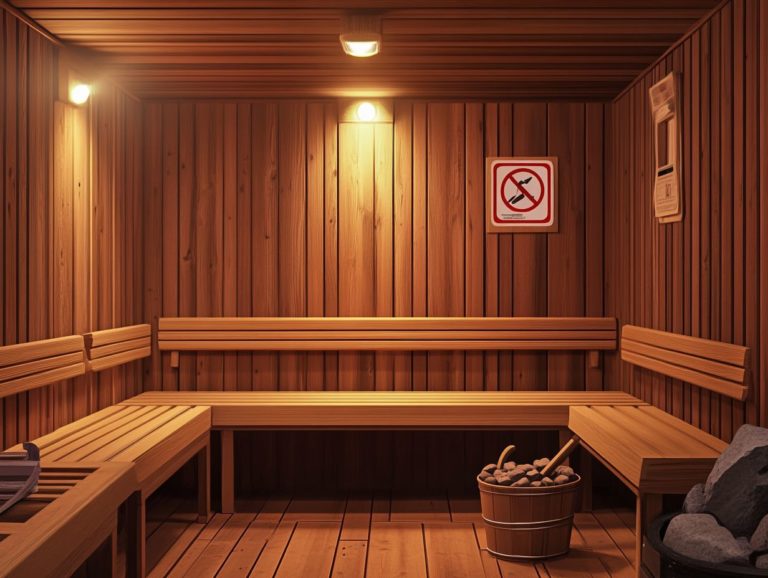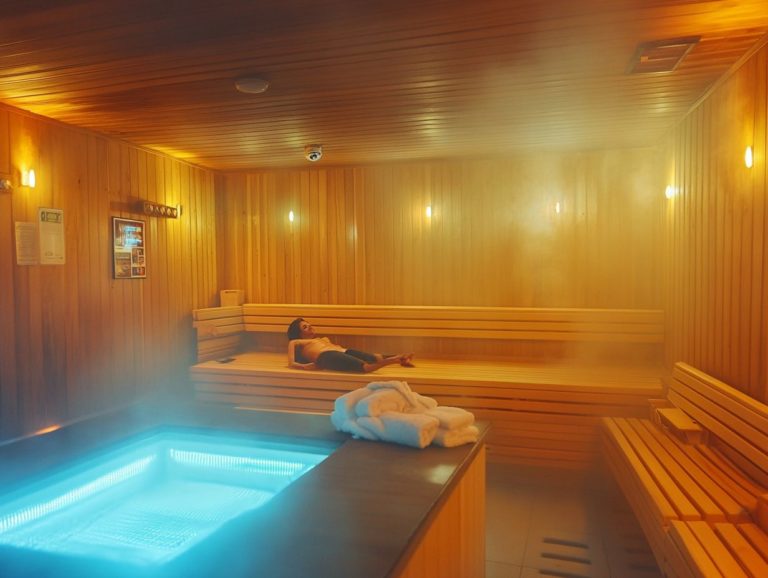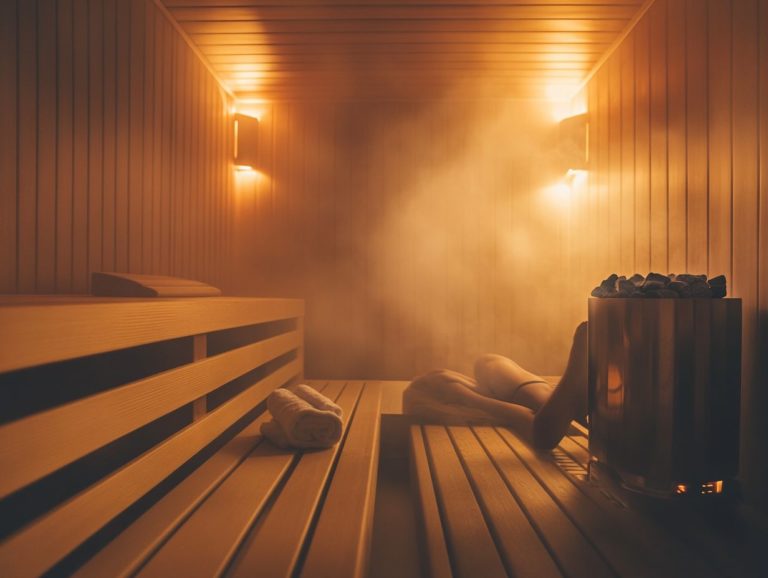Sauna Safety: What to Do in Emergencies
Saunas provide a sublime escape, yet grasping the nuances of sauna safety is essential for a truly enjoyable experience. Get ready to explore the world of saunas!
This article will guide you through the fundamentals of what a sauna is and how it functions. You’ll also discover important steps to address common emergencies such as heat exhaustion and burns. You will find crucial information to keep your sauna sessions safe and enjoyable.
You’ll also learn important first aid techniques for managing unexpected situations and understand when it’s time to seek medical attention. Don t wait learn how to enjoy saunas safely today!
Contents
- Key Takeaways:
- Understanding Sauna Safety
- Common Emergencies in Saunas
- Preventing Emergencies in Saunas
- Responding to Emergencies in Saunas
- When to Seek Medical Attention
- Frequently Asked Questions
- What should I do if someone gets overheated in the sauna?
- What should I do if someone passes out in the sauna?
- What should I do if there is a fire in the sauna?
- What should I do if the sauna becomes too hot?
- What should I do if someone collapses in the sauna?
- What should I do if there is a power outage while using the sauna?
Key Takeaways:
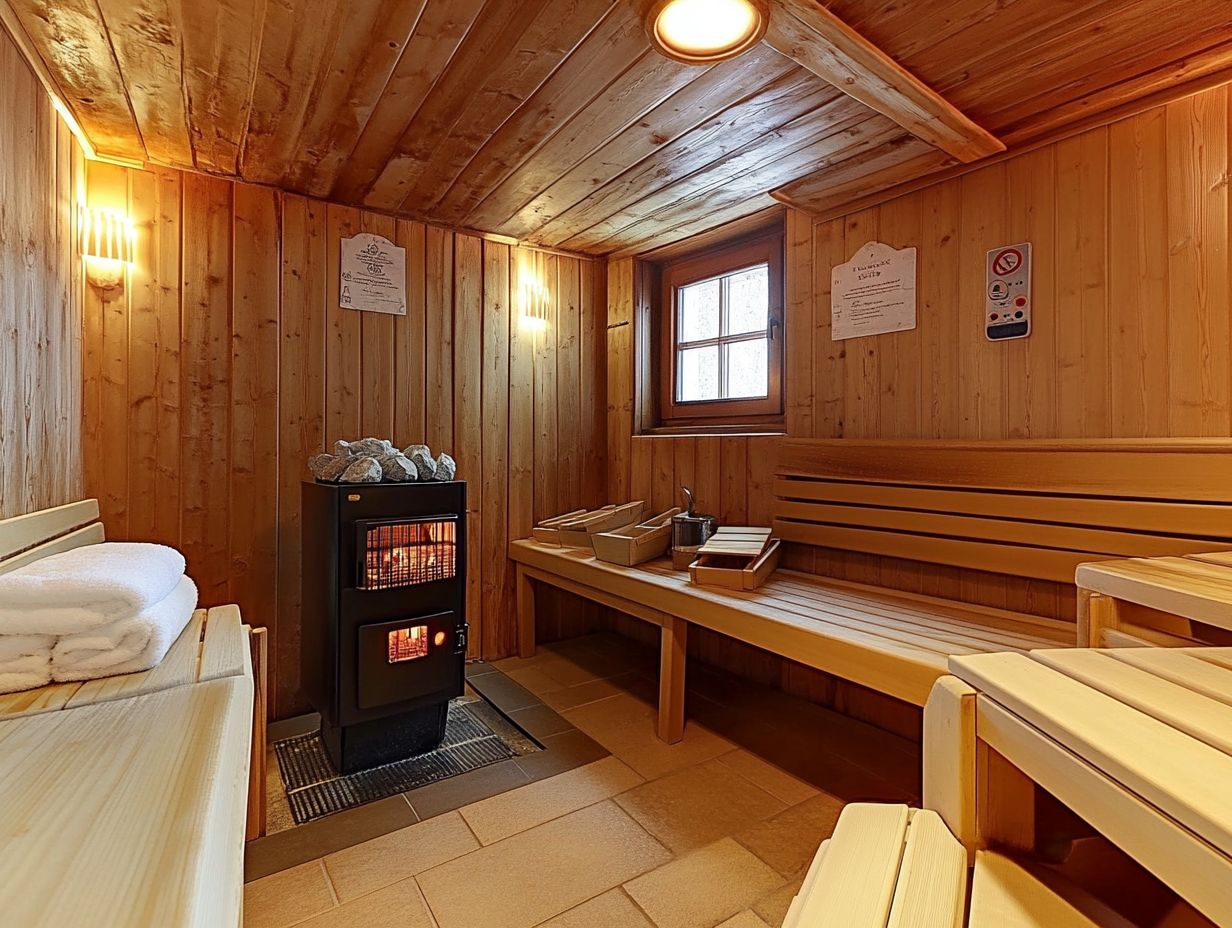
- Stay hydrated.
- Take breaks to avoid heat exhaustion.
- Use caution and follow safety precautions to prevent burns and injuries.
- In case of an emergency in the sauna, seek medical attention if there are signs of respiratory distress, fainting, or severe burns.
Understanding Sauna Safety
Understanding sauna safety is essential for you as a sauna user, as it covers various aspects that ensure your experience is both safe and enjoyable. While a sauna can provide wonderful benefits for relaxation and health, it can also present fire safety risks if the right protocols aren’t adhered to.
It’s vital for you to familiarize yourself with potential emergency situations, including fires. By implementing crucial safety measures like checking the sauna regularly, ensuring adequate ventilation, and being aware of fire protection equipment such as smoke detectors and fire extinguishers you can significantly reduce these risks and fully enjoy your sauna experience.
What is a Sauna and How Does it Work?
A sauna is your personal retreat, a cozy chamber designed to envelop you in high temperatures, allowing you to unwind while removing harmful substances from your body. Typically crafted from wood, saunas employ various heating methods, such as electric heaters or wood-burning stoves, to create an inviting, soothing environment.
This warmth triggers your body to sweat, promoting detoxification and enhancing circulation, which is why saunas have become a staple in wellness and fitness centers. Among the various types, traditional Finnish saunas stand out, utilizing hot stones and steam to elevate the temperature and deliver a distinct, moist heat experience.
On the other hand, infrared saunas use special light to heat your body directly rather than the surrounding air, often appealing to those who prefer a milder climate. Each sauna type offers its own unique benefits. Many find that the comforting warmth encourages muscle relaxation and alleviates stress, making it an ideal escape from life s daily pressures.
Whether you’re unwinding after an intense workout or a demanding day, indulging in sauna sessions often results in a lifted mood, deeper sleep, and improved skin health. This age-old practice seamlessly integrates into your wellness routine, showcasing its diverse advantages.
Common Emergencies in Saunas
Common emergencies in saunas can strike without warning, making it essential for you to be prepared for a range of potential situations. Heat exhaustion and dehydration often occur due to the elevated temperatures typical in saunas, and addressing these concerns promptly is crucial to your health.
Moreover, burns and other injuries can result from improper use of sauna equipment or prolonged exposure to excessive heat, underscoring the importance of staying aware and informed as a user.
Heat Exhaustion and Dehydration
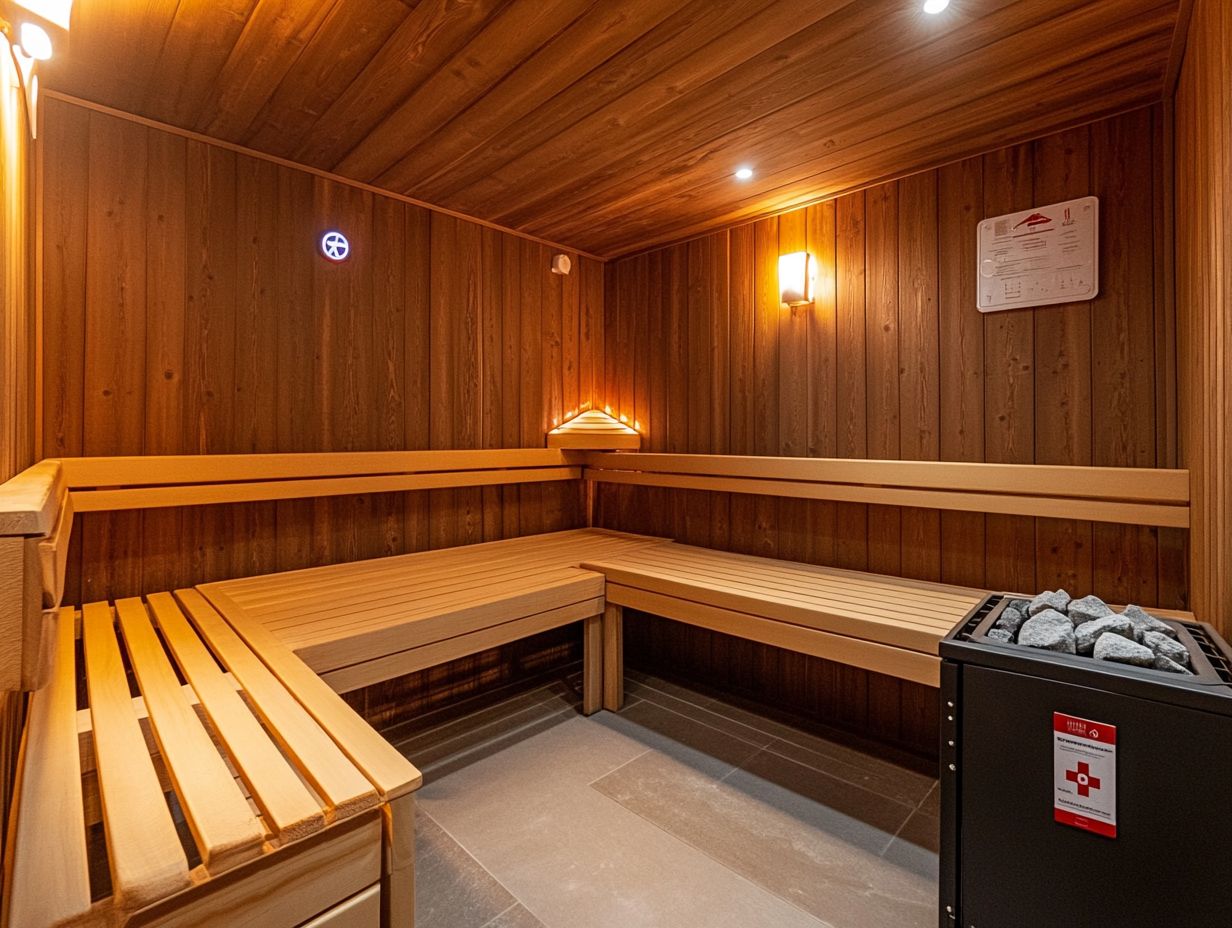
Heat exhaustion and dehydration are serious risks that can impact you during sauna use if you don t take the necessary precautions. You might experience symptoms like dizziness, headaches, excessive sweating, and fatigue. These can escalate into more severe conditions if you don t address them promptly.
It’s essential to stay hydrated and take breaks during your sauna sessions to minimize these risks.
Dehydration happens when your body loses more fluids than it takes in, especially during intense heat exposure and sweating. As a sauna enthusiast, keeping a water bottle within reach is a smart move to encourage regular hydration.
Instead of pushing yourself to stay in longer than advisable, consider stepping out periodically to cool down. This not only aids in recovery but also enhances your overall enjoyment of the experience. Integrating electrolyte-rich drinks into your routine can further help replenish those lost minerals.
By practicing these prevention strategies, you ensure a safer sauna experience while enjoying the health benefits of heat therapy.
Burns and Other Injuries
Burns and other injuries can pose significant hazards in saunas, often stemming from improper equipment use or negligence in adhering to fire safety protocols. As a sauna user, you should remain vigilant about hot surfaces, particularly heaters and stone benches, which can inflict serious burns upon contact.
You might also encounter slip and fall accidents due to wet floors or inappropriate footwear. There s also the possibility of dehydration or heat exhaustion if you neglect to take breaks or fail to hydrate adequately.
To minimize these risks, familiarize yourself with how the sauna equipment operates, ensuring that ventilation, which helps circulate fresh air, is adequate and that timers function properly. Setting a time limit for your sessions and taking regular cool-down breaks can further enhance your safety. By implementing these precautions and staying attentive, you can savor a safe and rejuvenating experience while significantly reducing the likelihood of injuries.
Preventing Emergencies in Saunas
Act now to prevent emergencies in saunas! This ensures a safe haven for users and requires a thoughtful blend of proper usage and proactive safety measures.
Key practices include:
- Conducting regular maintenance inspections
- Ensuring adequate ventilation
- Strictly adhering to fire safety protocols
By staying informed and vigilant, you can fully embrace the benefits of the sauna while effectively minimizing fire risks and other potential emergencies.
Proper Use and Precautions
Proper use and precautions are vital for ensuring your safety in saunas; neglecting established safety protocols can lead to emergencies you definitely want to avoid. Familiarize yourself with the sauna s features, including the locations of fire extinguishers and smoke detectors, and be diligent about following guidelines on session duration and hydration.
To truly enhance your sauna experience, limit your sessions to 15-20 minutes, particularly if you’re new to it or have any underlying health conditions. Staying hydrated is essential, so be sure to drink water before and after each session to ward off dehydration.
Be mindful of the safety tools at your disposal, such as emergency shut-off switches, which allow you to quickly turn off the sauna in emergencies, and temperature controls, which help maintain a safe heat level. It’s also wise to enter the sauna dressed appropriately think bathing suit or towel to minimize the risk of burns from heated surfaces.
Always watch for signs of overheating, like dizziness or nausea; recognizing these symptoms can be crucial for ensuring your experience is both safe and enjoyable.
Responding to Emergencies in Saunas
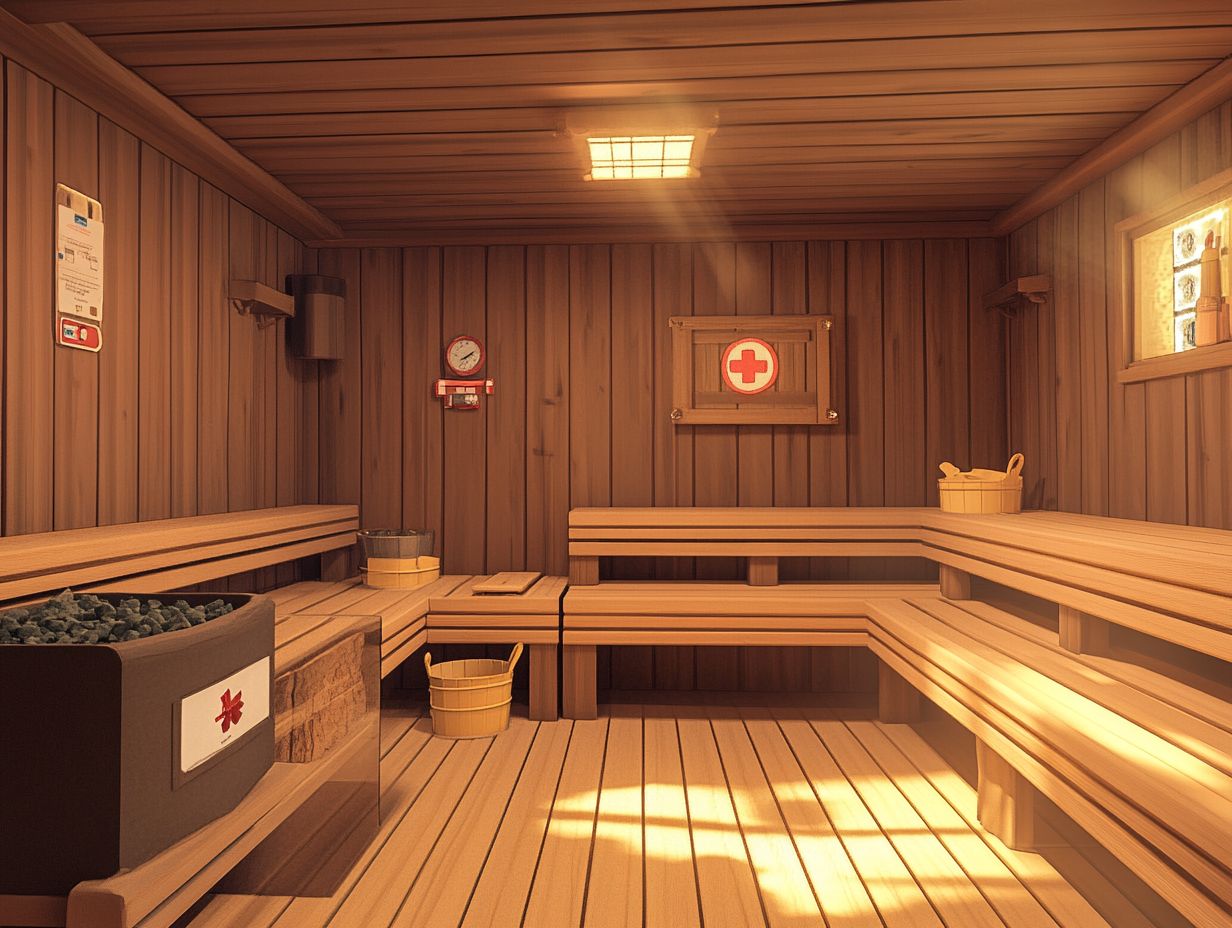
Responding to emergencies in saunas demands a well-thought-out emergency plan and a solid grasp of first aid techniques to safeguard sauna users.
Whether faced with heat exhaustion, dehydration, or burns, your preparedness can dramatically influence the outcome. Equip yourself with proper first aid training and a clear understanding of emergency procedures to act swiftly and effectively during critical situations.
First Aid Techniques
Sauna users must understand first aid techniques, especially in emergencies like heat exhaustion or burns. Your immediate response could involve cooling the individual, providing hydration, or treating burns with cool water.
This knowledge helps you act swiftly and effectively when confronting alarming symptoms such as dizziness, nausea, or excessive sweating.
If someone is experiencing heat exhaustion, it’s crucial to:
- Move them to a cooler area
- Loosen any tight clothing
- Help them sip water or an electrolyte drink slowly to rehydrate
In cases of burns, applying cool not ice-cold water can alleviate pain and prevent further skin damage. These essential first aid techniques not only ease discomfort but also significantly reduce the risks of serious complications, underscoring the importance of being prepared for anyone enjoying the sauna experience.
When to Seek Medical Attention
Understanding when to seek medical attention is crucial for sauna users. If symptoms like dizziness, confusion, or severe burns persist despite basic first aid measures, seek immediate medical assistance.
Recognizing the signs of serious conditions helps prevent complications and ensures your overall well-being during and after your sauna experience.
Signs and Symptoms to Watch For
Being attuned to the signs and symptoms that can arise during sauna sessions is essential for preventing emergencies and ensuring your safety. Watch for common indicators of heat exhaustion, such as heavy sweating, weakness, and dizziness.
If you notice redness, blisters, or severe pain, those could be signs of burns. Recognizing and responding to these symptoms promptly can truly be life-saving.
In the warmth of the sauna, you might also experience nausea or headaches clear signals that the heat is becoming too intense. If you’re prone to burns, stay vigilant for any skin irritation or discomfort that surfaces.
Check in with yourself and others to ensure everyone feels good. Ask questions about how everyone is feeling or if they’re feeling uncomfortably hot. Staying hydrated is critical as it helps your body regulate temperature effectively.
By being watchful and monitoring each other’s well-being, you can prevent more serious health issues and ensure a safer, more enjoyable sauna experience for everyone involved.
Watch the video above to learn more about sauna safety and first aid responses.
Frequently Asked Questions
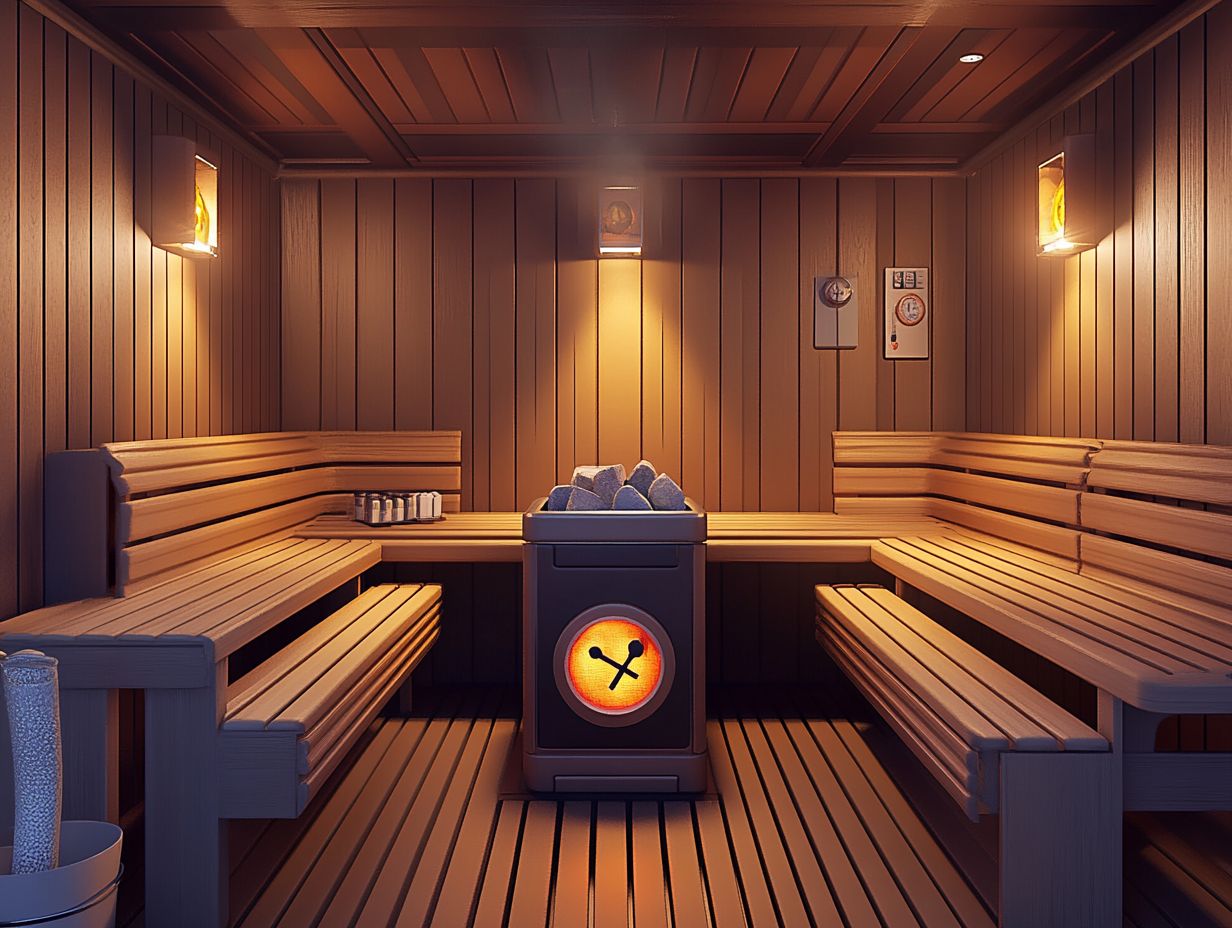
What should I do if someone gets overheated in the sauna?
Ensure that sauna users are aware of emergency situations and the proper steps to take. If someone becomes overheated in the sauna, act quickly. Immediately help them out of the sauna and into a cooler area. Offer them cool water and have them sit or lay down with their legs elevated. If they feel dizzy or lightheaded, have them lie on their back with their feet elevated.
What should I do if someone passes out in the sauna?
Remember that fire safety and safety protocols are essential to avoid further incidents. If someone passes out in the sauna, call for medical help immediately. While waiting for help, carefully remove the individual from the sauna and place them on their back with their legs elevated. Check their breathing and pulse, and administer CPR if necessary.
If you have any questions, don t hesitate to reach out! Sharing this information with friends can help everyone stay informed about sauna safety practices.
What should I do if there is a fire in the sauna?
Always have a fire extinguisher on hand and follow the established emergency plan. If a fire occurs, evacuate immediately and call for emergency services.
Do not use the sauna again until a professional has checked it and confirmed it’s safe.
What should I do if the sauna becomes too hot?
Ensure you have a way to cool down. Remind others about Xcell Misting or similar water mist systems.
If the sauna gets too hot, stay calm and leave the sauna right away. Open the doors and windows for ventilation and wait until it cools down before re-entering.
What should I do if someone collapses in the sauna?
Assess the situation. If the individual is in distress, help them out of the sauna and lay them on their back with their legs elevated.
Check their breathing and pulse. Call for medical help if needed. Do not go back into the sauna until the person has fully recovered.
What should I do if there is a power outage while using the sauna?
Be aware that fitness centers may have specific protocols for power outages. If the power goes out, exit the sauna and turn off the heat source immediately.
Wait outside until the power is restored and the sauna has cooled down. Find alternative ways to cool off if needed until the power is back on.


